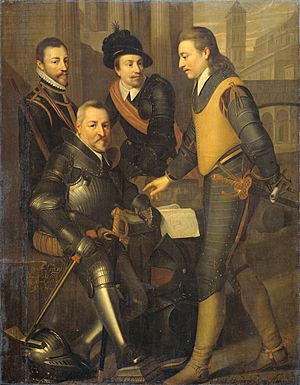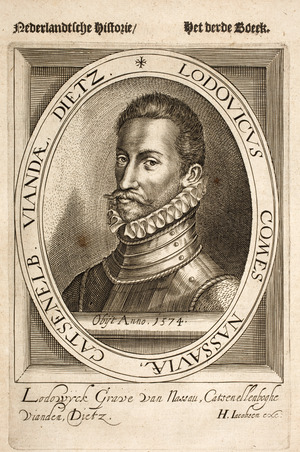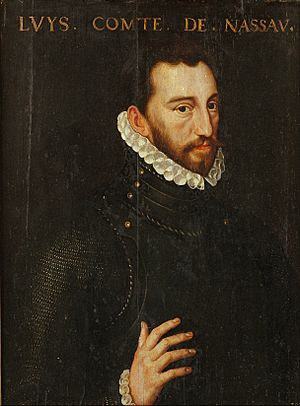Louis of Nassau facts for kids
Louis of Nassau was an important person in Dutch history. He was born on January 10, 1538, and died on April 14, 1574. He was the third son of William I, Count of Nassau-Siegen, and Juliana of Stolberg. He was also the younger brother of William of Orange, a very famous leader.
Louis played a big part in the Dutch Revolt, which was when the Netherlands fought for freedom from Spain. He was a strong Calvinist (a type of Protestant Christian). He helped his brother William a lot, even helping him arrange his marriage. In 1569, William made Louis the governor of Orange, which gave him an important role in French politics.
Contents
The Compromise of Nobles

In 1566, Louis was one of the leaders of a group of nobles. They signed a letter called the "Compromise of Nobles." This letter was a request to King Philip II of Spain. It asked him to stop the Inquisition in the Netherlands. The Inquisition was a harsh religious court.
On April 5, 1566, Louis and about 200 horsemen presented the letter. They gave it to the regent, Margaret of Parma. During this meeting, one of her advisors, Count Charles of Berlaymont, said something important. He tried to calm her by saying, "What, Madame, afraid of these beggars?" From that moment, the people who opposed the King's rules proudly called themselves "Beggars" (or "Geuzen").
The Battle of Heiligerlee

When the Duke of Alva arrived in the Netherlands, Louis and his brother William left the country. They gathered an army from outside. In 1568, with help from French Huguenots (French Protestants), they planned to invade from three sides.
Louis and his younger brother Adolf were to enter the northern Netherlands through Friesland. The other two groups were not successful. Louis's army was the only one to win a battle.
Louis entered Friesland on April 24. Alva sent an army to stop him. The two armies met at Heiligerlee on May 23. Louis set a trap for the Spanish troops. Louis's army won the Battle of Heiligerlee. Sadly, his younger brother Adolf died in the battle.
The Battle of Jemmingen
After the victory, William wanted Louis to retreat. But Louis stayed near Groningen. There, he met a much smaller army led by Alva himself. Alva had 2,000 Spanish soldiers, while Louis had 12,000 Protestant soldiers.
Louis's army fell back towards Jemmingen. On July 21, 1568, a fierce battle took place. Alva's army pushed Louis's soldiers over the bridges of the Ems River and into the river itself. Many soldiers drowned trying to cross. Louis took off his heavy armor and swam to safety. In the end, the Dutch rebellion lost 7,000 men at the Battle of Jemmingen.
The Capture of Mons
After the Battle of Jemmingen, Louis joined his brother William again. They went back to France and met with the Huguenot leader, Admiral Coligny. Louis fought in other battles in France. He became the governor of Orange, which helped him make stronger connections in France.
In 1572, a group called the Watergeuzen captured the city of Brielle. They claimed it for William. Soon, most cities in Holland and Zeeland were controlled by the rebels. William became the governor (stadtholder) of Holland and Zeeland again.
Louis quickly gathered a small army in France. On May 23, he entered Hainaut and captured the city of Mons. This surprised Alva. William tried to help his brother at Mons, but he couldn't.
Alva was able to get Mons to surrender. On September 19, Louis and his army left Mons with military honors. By drawing Alva's attention to Mons, Louis helped the northern provinces become stronger. Even though Mons was lost, Holland was now strong enough to resist Spain.
The Battle of Mookerheyde
By 1574, money was running out. The Spanish army was closing in on Middelburg and Leiden. William asked Louis for help, hoping he could create a distraction in the south.
That spring, Louis, along with his youngest brother Henry and Christopher of Bavaria, crossed the Meuse River with their army. They hoped to distract the Spanish, but they were outsmarted by the experienced Spanish leader, Sancho d'Avila.
Louis led the charge against the Spanish. He was shot in the arm. He tried to keep fighting, but he was losing blood quickly. His friends took him away from the battle to a nearby hut. There, he told his friends to save themselves. Louis was never seen again, neither alive nor dead. His brother Henry and Christopher of Bavaria also died in the Battle of Mookerheyde.
See also
 In Spanish: Luis de Nassau para niños
In Spanish: Luis de Nassau para niños


